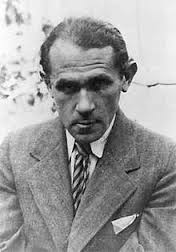Nash Holos: Bruno Schultz
Welcome to Ukrainian Jewish Heritage ... a radio series on Nash Holos Ukrainian Roots Radio ... sponsored by the Ukrainian Jewish Encounter based in Toronto, Ontario. Audio is here.
Alfred Schreyer, Holocaust survivor, musician and student of writer and artist Bruno Schultz, died on April 25, 2015. Born in Drohobych, Ukraine on May 8, 1922, Schreyer spent much of his life in this Western Ukrainian town. Nash Holos will shortly feature the life of Schreyer, a man who was beloved both in his native Ukraine and Poland. Meanwhile, Nash Holos reflects on the life of Schultz, who at one time was Schreyer’s teacher.

Drohobych is a town in the Lviv region of Ukraine, and the homeland of Bruno Schultz – a writer, literary critic, fine artist and teacher of art.
Schultz was born to Jewish parents and is regarded as one of the great Polish-language prose stylists of the 20th century. He attended school in Drohobych from 1902 to 1910, then went on to study architecture at Lviv Polytechnic. In 1917 he briefly studied architecture in Vienna.
Schultz was discouraged by influential colleagues from publishing his first short stories. However, that changed when several letters he wrote to a friend were brought to the attention of the famous Polish novelist Zofia Nałkowska. The letters detailed Schultz’s solitary life and the lives of his family and fellow citizens.
Nałkowska encouraged Schultz to have the letters published as short fiction. They were published in 1934 as The Cinnamon Shops. In English-speaking countries, it is most often referred to as The Street of Crocodiles.
He went on to write a number of critical essays for various newspapers, and short stories for magazines. Due to World War Two, much of his work has been lost.
In 1939, after the Nazi–Soviet invasion of Poland in World War II, Drohobych was occupied by the Soviet Union. Schultz had been working on a novel called The Messiah, but no trace of the manuscript survived his death.
As a Jew, Schultz was forced to live in the ghetto of Drohobych. However he was temporarily protected by Felix Landau, a Nazi Gestapo officer who admired his drawings. During the last weeks of his life, Schultz painted a mural in Landau's home in Drohobych. Shortly after completing the work, Schultz was walking home through the "Aryan quarter" with a loaf of bread when he was shot and killed by Karl Günther, another Gestapo officer.
Günther was a rival of Landau, who had killed Günther's "personal Jew." Subsequently, Schultz's mural was painted over and forgotten for a long time to come.
In February 2001, Benjamin Geissler, a German documentary filmmaker, discovered the mural that Schultz had created for Landau. Polish conservation workers, who had begun the meticulous task of restoration, informed Yad Vashem, Israel’s official Holocaust memorial, of the findings. In May of that year representatives of Yad Vashem went to Drohobych to examine the mural. They removed five fragments of it and transported them to Jerusalem.
This created an international controversy, and public outrage in Poland and Ukraine, where Schulz is a beloved figure.
In 2008, the issue was resolved when Israel recognized the works as the property and cultural wealth of Ukraine, and Ukraine's Drohobych Museum agreed to lend the works to Yad Vashem as a long-term loan. The works went on public display in 2009.
In Drohobych you can see the house where Bruno Schultz lived. There is a memorial plaque not far away on Landau’s house, and another at the site where Schultz was shot.
You can see other beautiful Schultz frescoes in the local Drohobych art museum. As well Drohobych is host to the International Bruno Schultz Festival.
Until next time, Shalom.



















